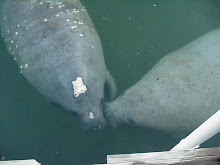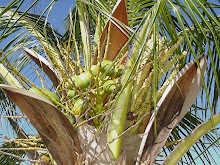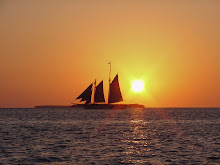After breakfast we visited the Submarine Learning Center.
I do believe that was one of my favorite things on the entire trip.
We were met by a submariner who gave us a briefing on what submariners do and what it takes to become one. It takes lots of math and science plus a certain mindset to be able to withstand being underwater, in a confined space, for long periods of time.
I have to remind myself to breathe when I watch submarine movies...so that disqualifies me for the job, let alone my less than stellar math and science skills, my current age, my gender (although females will become submariners by 2012 in officer billets) and never having the desire to become a submariner in the first place.
I have a new respect for all submariners now.
After the briefing we were taken to the training area that housed the computerized virtual simulator. Spud got a chance to step into the simulator and strap on a some goggles. The computer tech punched some buttons and Spud was then visually transported to the bridge of a sub. The rest of us were able to see what Spud saw in his goggles on a television screen.

 The computer could be set to simulate a large number of ports around the world in perfect detail. The tech could manipulate the simulations. He could change the weather and roughness of the seas. He made it snow in Pearl Harbor.
The computer could be set to simulate a large number of ports around the world in perfect detail. The tech could manipulate the simulations. He could change the weather and roughness of the seas. He made it snow in Pearl Harbor.
The simulator was voice activated too. The student (or cadet in our situation) could use a handheld radio mike to give orders and direction to the simulated sub and it would make the course changes. What a great training tool.
After the virtual training experience we made our way to a mechanical training system. It was a mock up of a submarine bridge. The cadets sat down at key positions on the bridge and our tour guide, an active duty submariner, set up a simulation for a submarine dive.
The cadets helped with the dive by sounding the alarm (it sounded like a loud school bell) and working the "stick" or steering wheel. The tour guide told the cadet who was at the stick what number the controls needed to read to achieve the deep dive. The cadet would push in the stick until the desired number was reached on the control panel. The entire bridge of the simulator pitched forward and we all had to hang in order not to tumble forward.


After the dive it was time to simulate a surfacing. We simulated the extreme surface like the submarine did in
The Hunt for Red October...a steep incline and then an abrupt landing on the water's surface.
The alarm was sounded again and Spud had to simulate blowing the ballasts. He grabbed onto two levers called the "chicken legs" because they resemble a couple of drumsticks.

We had to once again hold on for dear life during the surfacing because the platform's angle was steep. I kinda felt like the crew of the Star Trek Enterprise...remember how they would have to grab onto something on the bridge when the Enterprise was struck by enemy photon torpedoes?
It all felt so realistic. I loved it!
Next...time for lunch and another shopping trip at the NEX and then onto a tour of a real submarine...the USS Scranton.
No cameras were allowed on or around the Scranton so I do not have any pictures of our tour but here is a picture I got off the Internet so that you can get an idea of what we toured. The sub is about 362 feet long and has 12 officers and 98 men aboard as its crew. It has a nuclear propulsion system.

The sub was tied at dockside and was undergoing some cosmetic repairs (painting). We walked up a gangplank and onto the topside of the sub near the back of the sail (that tall black stack on the back of the sub). We continued walking forward topside until we reached the hatch that would gain us entry to the Scranton. The hatch is just in front of the sail.
One at a time we climbed down the ladder into the sub and landed in a narrow hallway, barely wide enough for one person. To allow anyone to pass us in the hall we had to press ourselves against the wall.
We toured the little mess hall and I peeked my head into the tiny galley (kitchen) and we also peeked into the officer and enlisted quarters...again tiny.
I felt a bit claustrophobic just taking the tour. I'd make a terrible submariner. I wouldn't last in such a confined space, under all that water for those long periods of time. I appreciate and am in awe of those who can and do.
Lorrie and I opted not to go down into the bottom deck of the sub, the torpedo room; it was crowded with cadets and was going to get even more packed when the remaining cadets went down.
Lorrie and I exited the sub, and as I was clearing the hatch I scraped my left shin on the hatch's edge. Thankfully Lorrie had some facial tissues (I gave them to her a couple of days earlier) I could use to staunch the blood flow. Could this be considered being wounded in action?
The sub visit was over and we had time to spare before dinner so we boarded the bus for a guided tour of the naval base. That was nice.
Dinner behind us, back to the barracks, more P.T. for the cadets, showers and lights out.
End of day five.
 The cadets are in charge of cleaning the barracks (Lorrie and I swept our rooms). The girls have cleaned the barracks so that we leave it in better condition than we found it. The male cadets do the same.
The cadets are in charge of cleaning the barracks (Lorrie and I swept our rooms). The girls have cleaned the barracks so that we leave it in better condition than we found it. The male cadets do the same.

 We watch movies and sleep on the way home. I must have slept soundly for a while because I missed bus driver Tom's departure and his replacement driver take over. We stop for dinner in South Carolina.
We watch movies and sleep on the way home. I must have slept soundly for a while because I missed bus driver Tom's departure and his replacement driver take over. We stop for dinner in South Carolina.

 It was about a two and a half hour drive from the navy base to the marine base. We once again drove through the Chesapeake Bay Bridge Tunnel (we'd been through it a couple of times before during our trip). The tunnel is impressive. It goes under the bay's water anywhere from 25 to 100 feet deep and is one mile long.
It was about a two and a half hour drive from the navy base to the marine base. We once again drove through the Chesapeake Bay Bridge Tunnel (we'd been through it a couple of times before during our trip). The tunnel is impressive. It goes under the bay's water anywhere from 25 to 100 feet deep and is one mile long. It was tiled in white subway-like tile. I would have hated to be the one to take on that tile job.
It was tiled in white subway-like tile. I would have hated to be the one to take on that tile job. I'm glad that we never got stuck in the tunnel because of an accident or traffic jam...being under all that water...remember I would not make a good submariner!
I'm glad that we never got stuck in the tunnel because of an accident or traffic jam...being under all that water...remember I would not make a good submariner!

 Our next stop was the National Museum of the Marine Corps. Very impressive. I would have liked more time there. The displays were very realistic and interactive. I experienced motion, sound and temperature changes depending on what battle was being depicted.
Our next stop was the National Museum of the Marine Corps. Very impressive. I would have liked more time there. The displays were very realistic and interactive. I experienced motion, sound and temperature changes depending on what battle was being depicted.


 We had dinner at the marine mess hall after the museum visit before hitting the road again for our long ride back to the barracks.
We had dinner at the marine mess hall after the museum visit before hitting the road again for our long ride back to the barracks.
 The computer could be set to simulate a large number of ports around the world in perfect detail. The tech could manipulate the simulations. He could change the weather and roughness of the seas. He made it snow in Pearl Harbor.
The computer could be set to simulate a large number of ports around the world in perfect detail. The tech could manipulate the simulations. He could change the weather and roughness of the seas. He made it snow in Pearl Harbor.
 After the dive it was time to simulate a surfacing. We simulated the extreme surface like the submarine did in The Hunt for Red October...a steep incline and then an abrupt landing on the water's surface.
After the dive it was time to simulate a surfacing. We simulated the extreme surface like the submarine did in The Hunt for Red October...a steep incline and then an abrupt landing on the water's surface.
 The sub was tied at dockside and was undergoing some cosmetic repairs (painting). We walked up a gangplank and onto the topside of the sub near the back of the sail (that tall black stack on the back of the sub). We continued walking forward topside until we reached the hatch that would gain us entry to the Scranton. The hatch is just in front of the sail.
The sub was tied at dockside and was undergoing some cosmetic repairs (painting). We walked up a gangplank and onto the topside of the sub near the back of the sail (that tall black stack on the back of the sub). We continued walking forward topside until we reached the hatch that would gain us entry to the Scranton. The hatch is just in front of the sail.




 We were not able to take a ride on the LCAC.
We were not able to take a ride on the LCAC. LCACs can travel over 46 mph. That would have been a great ride.
LCACs can travel over 46 mph. That would have been a great ride.
 Lunch (you guessed it, the Navy mess hall) was sandwiched between the SEALs and our next stop.
Lunch (you guessed it, the Navy mess hall) was sandwiched between the SEALs and our next stop.


 Both boats are used in search and rescue efforts as well as recreational boating safety and fisheries regulation. Everyone at the Coast Guard Station were extremely nice and knowledgeable.
Both boats are used in search and rescue efforts as well as recreational boating safety and fisheries regulation. Everyone at the Coast Guard Station were extremely nice and knowledgeable.
 We visited the ship's bridge, the deck, the Marine bunks (they could accommodate 1900 Marines, stacked four high. It was like a maze in there. I would need a GPS to find my bunk), the very bottom deck of the ship that could be flooded with sea water so that boats could be brought aboard (the water level would be another 8 to 10 feet above the Captain and Chief's heads) and a other sections of the ship like the anchor room and mess hall (not pictured).
We visited the ship's bridge, the deck, the Marine bunks (they could accommodate 1900 Marines, stacked four high. It was like a maze in there. I would need a GPS to find my bunk), the very bottom deck of the ship that could be flooded with sea water so that boats could be brought aboard (the water level would be another 8 to 10 feet above the Captain and Chief's heads) and a other sections of the ship like the anchor room and mess hall (not pictured).


 Before we left the ship we took a group shot of the cadets on deck.
Before we left the ship we took a group shot of the cadets on deck.
 This is the Governor's Palace. Thomas Jefferson was the last Governor of Virginia to reside here before the Capital was relocated to Richmond in 1780 upon Jefferson's request for security reasons during the American Revolution.
This is the Governor's Palace. Thomas Jefferson was the last Governor of Virginia to reside here before the Capital was relocated to Richmond in 1780 upon Jefferson's request for security reasons during the American Revolution. I was able snap a few more pictures during our brief visit.
I was able snap a few more pictures during our brief visit. Some of the locals.
Some of the locals.


 I enjoyed my revisit to Colonial Williamsburg but wished it could have been longer; too soon we had to board the bus again and head back to the barracks.
I enjoyed my revisit to Colonial Williamsburg but wished it could have been longer; too soon we had to board the bus again and head back to the barracks. When we got back to the barracks the cadets began their P.T. They stretched to warm-up and then began the 2 mile run to the beach. Lorrie and I walked to the beach and put our toes into the water.
When we got back to the barracks the cadets began their P.T. They stretched to warm-up and then began the 2 mile run to the beach. Lorrie and I walked to the beach and put our toes into the water. The Captain and Chief opted for a pizza night at the barracks once everyone was back from the run instead of getting back on the bus and eating at the navy mess hall. Everyone was tired, so that was a great plan.
The Captain and Chief opted for a pizza night at the barracks once everyone was back from the run instead of getting back on the bus and eating at the navy mess hall. Everyone was tired, so that was a great plan.

































